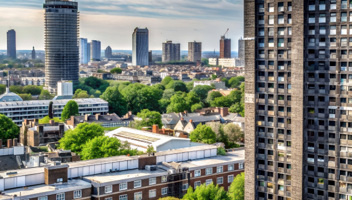The Scottish Government has announced its “next big step” towards addressing the cladding crisis in Scotland: expanding the Single Building Assessment Programme and developing a “Scottish Safer Buildings Accord”.
However, this is not the only big step to recently impact Scottish developments. Here are our top five from the last month.
1. Voluntarily "stepping up" by developers
The context – the English Pledge
In England, Mr Gove’s plan is to persuade larger developers to voluntarily sign a pledge to remediate life-critical fire safety issues, otherwise draconian measures will be deployed against them including blocking them from the housing market in England.
This plan is backed up in law through late amendments to the Building Safety Act 2022 (BSA) eg. A new power to prohibit developments by prescribed organisations.
Mr Gove’s stated targets are larger developers who played a role in developing buildings of 11 metres and above in England. As of 12 April 2022, 36 developers had signed the pledge.
The Scottish Accord
Against this backdrop, the Scottish Housing Secretary, Ms Robison, informed Scottish Parliament on 12 May that Homes for Scotland, the house building members body, has agreed to work with the Scottish Government to develop a Scottish Safer Buildings Accord with their members and the broader sector.
What will the Accord say? The fine detail is to be worked out in the coming weeks. Will it mirror the English pledge with its wide reaching principles?
Who will be asked to sign the Accord? Will it be restricted to larger developers like the English pledge or will small and medium sized developers also be asked to sign? Will Ms Robison have greater success in engaging the broader sector than Mr Gove has had in England?
As yet, there has been no change to the underlying law which would allow sanctions to be imposed by the Scottish Government in the event of failure to sign the Accord. Ms Robison did however conclude in her statement to the Scottish Parliament that “…I want to also make clear that if required, I will make full use of the powers available to us to bring parties to the table, including if necessary, using legislation to do so.”
As for funding, there is still a lack of clarity about the available amount. What is clear is that public funding may not be enough, and it will only be used where a developer or known parent cannot be identified.
It is important to note that the Scottish Government has emphasised that it expects the vast majority of buildings to be found to be safe.
The full statement by Ms Robison to the Scottish Parliament can be viewed here.
2. Expansion of the Single Building Assessment (SBA) Programme
SBAs are a uniquely Scottish solution to carrying out free assessments of whole blocks of domestic residential buildings.
On 12 May, Ms Robison also announced that:
- the pilot project of 26 buildings is to be expanded to a national programme; and
- to allow the programme to be scaled up, assessments will now be managed by the Scottish Government directly.
3. The Building Safety Act 2022 ("BSA")
The BSA was passed in April by the UK Parliament. It comes into force in stages.
If you operate in England, this is the piece of legislation you have to get up to speed on as a matter of urgency. If you operate in Scotland, the majority of it will not apply. However, there are certain parts of it which will apply and must not be overlooked.
The following high-level table contains just a few of the key changes to demonstrate this point:
|
Building Safety Act 2022 |
England |
Scotland |
|
Building Safety Regulator (operating within HSE) |
no | |
|
Higher-risk buildings regime with dutyholders, gateways and a golden thread of information throughout the lifecycle of a building |
yes | no |
|
Building safety levy (sometimes called the Gateway 2 levy) - applicable to all residential buildings |
yes | no |
|
Prohibition on development of land in England and building control for prescribed persons |
yes | no |
|
Building liability orders against associated companies |
yes | no |
|
Extending scope of claims that can be pursued under Defective Premises Act 1972 and Building Act 1984, and extending period for making claims |
yes | no |
|
New Homes Ombudsman Scheme and developers’ code of practice |
yes | yes |
|
New build home warranties |
yes | no |
|
Construction Products: regulation of the supply and marketing of construction products; new liability relating to construction products; new liability for past defaults relating to cladding products; extension of time bar period for claims, and cost contribution orders |
yes | yes |
|
Architects’ competence |
yes |
yes |
4. Ban on combustible cladding
The new Building (Scotland) Amendment Regulations 2022 apply in Scotland only. They come into force on 1 June 2022.
Developers are banned from using combustible cladding on high-rise buildings. Since 2005, new cladding systems on high rise blocks of flats have either had to use non-combustible materials or pass a large-scale fire test.
The new legislation removes the option of a fire test, completely prohibiting such materials from use on domestic and other high-risk buildings, such as care homes and hospitals, above 11metres.
5. New statutory causes of actions for construction products
The BSA creates many new rights of redress for defective work.
This includes new building liability orders against associated companies; expanding the scope of the claims that can be pursued; and lengthening the period within which such claims can be pursued (up to 30 years for some historic claims). The Government Redress Factsheet contains a helpful summary. These changes apply in England only.
In Scotland, no such changes have been made: the legal basis on which claims relating to building safety can be pursued has not changed, nor has the time bar period which is usually 5 years.
However, as a result of a late amendment to the BSA, two significant changes to Scots law were introduced, neither of which were consulted on beforehand.
These are new statutory causes of action:
(1) relating to construction products, which can be brought for up to 15 years prospectively; and
(2) for historical defaults relating to cladding products, which can be brought for up to 15 years prospectively or 30 years retrospectively.
Both causes of actions are heavily qualified and will require careful application to the facts. These new statutory rights will apply in both England and Scotland.
For all those engaged in the construction sector, it is going to be long summer of assessing the impact of multiple building safety changes on businesses.
Related News, Insights & Events

Courts provide guidance on “reasonability” in compensation on termination recovery
A new decision from the Privy Council has provided some guidance on the limits of provisions around the recovery of supply chain costs upon termination for convenience or employer default.

Knowing where you stand is key for agricultural businesses navigating IHT changes
The inheritance tax (IHT) changes scheduled to be introduced in April 2026 are far reaching and of concern to all business owners, but none more so than those in the agricultural industry.

UK government’s response to Grenfell inquiry phase 2 – 10 takeaways
On 26 February 2025, the UK Government published its much anticipated 80-page response to the Phase 2 Report of the Grenfell Tower Inquiry, published in September 2024.





